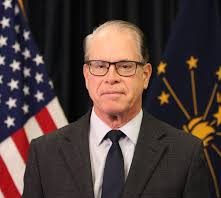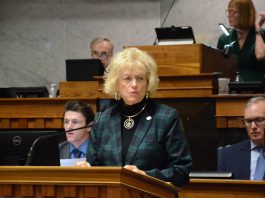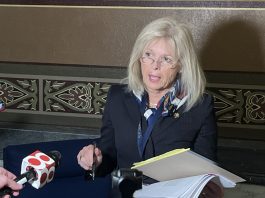TheStatehouseFile.com
INDIANAPOLIS–After 11 months of paperwork and preparation, Natalie Young was ready to jumpstart her potential son’s adoption from Guatemala. All she needed was approval from his birth country.
One day shy of getting the green light to move forward, Young and her family were blindsided.
“I got the email Tuesday morning saying Guatemala was closed,†she said. “Which means if Guatemala had already accepted me, then I would be able to finish the process. But I hadn’t started yet.â€
The abrupt cut off left Young speechless – she didn’t expect Guatemala to completely shut down all international adoptions. This elimination adds to a steady global decline of foreign adoptions, which has seen a 72 percent decrease since 2005, according to a recent study.
Countries that once released hundreds of children each year – like Ethiopia, China, Russia, and Guatemala – have seen their adoption programs drop sharply or shut down altogether.
Young, who chose international adoption after struggling with infertility, was exhausted and empty-handed.
“I was devastated,†Young said. “We knew we were getting a boy. But the country closed and we were heartbroken.â€
International adoption declines have crushed the hopes of many American families who dream of taking in a foreign child.
Those same families are now fearful their chances of adopting will be even slimmer after the U.S. State Department increased fees and restrictionson adoption agencies earlier this year.
Fears At Home
Panic spread across the adoption community after a new accrediting entity was created to monitor adoption agencies in June 2017. As the country’s central authority for international adoptions, the U.S. State Department designated the Intercountry Adoption Accreditation and Maintenance Entity (IAAME) to monitor adoption service providers.
United States law requires that all American adoption agencies receive approval from an accrediting entity. For the past 12 years, that entity was the Council for Accreditation (COA).
American adoption agencies receive approval from an accrediting entity. For the past 12 years, that entity was the Council for Accreditation (COA).
However, the COA withdrew from its role a few months after its partner was introduced, leaving the IAAME as the sole accreditor for American agencies. They are tasked with monitoring adoption agencies to ensure ethical and fiscal standards are met. Accrediting entities also have the ability to cite and shut down agencies they determine to have failed those standards.
When the IAAME released its fee schedule for agencies in February, eyebrows were raised from critics and adoption advocates alike.
“For some agencies, they’re going to be paying tens of thousands or more per year than they used to,†said Ryan Hanlon of the National Council For Adoption. “It’s a significant increase in the number of fees that agencies are paying for monitoring and oversight.â€
Previously, monitoring and oversight fees under the COA were charged at a flat rate, based on the revenue of an adoption agency. The combined fees paid over a four-year cycle ranged between $12,000 and $18,000, regardless of the number of adoptions an agency performed.
Under the IAAME, accreditation fees are based on the number of cases an agency performs, with an additional $500 monitoring and oversight fee charged per each new adoption case.
Although agencies were informed they could pass this additional charge onto adoptive parents, Hanlon argues that the State Department is being purposefully misleading.“This isn’t a fee that’s being charged to families, it’s a fee that’s being assigned to agencies,†he said. “They don’t have a choice by the way. They are required to pay this new fee.â€
Hanlon, who advocates on behalf of families pursuing foreign adoption, said many agencies are concerned about increasing expenses and difficulties that future adoptive parents are facing.
“They’re also just looking at, ‘What does this mean for more monitoring and oversight,’†he said. “Is this just going to make it even more difficult to serve families and to serve children?â€
 Staying Afloat
All Blessing International, a mid-size Kentucky based adoption agency created and directed by Lucy Armistead, is faced with the reality that in a few years it may have to close its doors for good.
Armistead said she joined the international adoption movement because she realized it was a “worthwhile pursuit†to unite families and children. Although she feels her agency has helped many children since its opening in 2002, she can’t ignore the negatives.
“Over the past several years it’s become so overregulated and the intensity of trying to interpret regulations is very much a stressful situation,†Armistead said.
At the start of her career, Armistead said she spent 80 percent of her time in the field working on cases with families. Now, about 80 to 90 percent of her time is spent keeping up with administrative tasks, record keeping, assessing policy and procedures required by the State Department.
The IAAME’s additional $500 fee and increased monitoring and oversight have Armistead worried about the impact it will make on her already heavy workload.
“It impacts us a lot,†she said. “Every time they ask us for something, it takes time away from the agency. I’m probably going to have to hire somebody else to come in to help with those particular tasks because nobody else at the agency has any extra time.â€
Hiring extra staff requires money, she said, which means families who want to adopt will be charged more in agency fees as they try to keep up with the costs.
“The fees for families are going to go up much more than $500 each,†Armistead explained. “It’s actually going to cost families, by my guestimate, $3,000 extra in agency fees.â€
She said even after increasing their fees drastically in anticipation of what the new monitoring and oversight may look like under the IAAME, she doesn’t know if it will be enough to stay in business.
All Blessings International previously paid $15,500 in accreditation fees to the COA over a four-year cycle. Under the IAAME, Armistead said the total cost in those same fees would be roughly $260,000.
“If agencies don’t have the ability to meet that monitoring and oversight based on their budget that they set years ago for families, then they’re going to have to go out of business because they’re not going to be compliant,†she said.
Rising Tensions
Critics are asking where the line is drawn to ensure that adoption service providers and families will be able to realistically afford the adoption process while making sure children are still protected.
Armistead argues that the previous safeguards and monitoring and oversight were sufficient up until recently – to the point she thinks now it’s causing more harm than good.
“We’re moving so far toward, ‘We have to make sure there’s absolutely zero chance of any possible ethical violation happening,’ that we’re disregarding the risk that the children have while they’re overseas in an orphanage,†Armistead explained.
Virgil Carstens, press officer for the State Department, did not directly address these concerns but reiterated the need for adoption agencies to meet accreditation standards.
“Accreditation standards address prohibitions on the buying of children, having a sound financial basis for the agency’s work,†Carstens said, “along with effective internal financial controls, transparency in fees and the adoption process, professional qualifications of agency personnel, and other practices ensuring ethical conduct and transparency in the adoption process.â€
Looking forward
At the mercy of tug and war between the State Department and adoption agencies, American families hoping to grow are left wondering whether international adoption will be a viable option in the future.
Young anticipated her son’s adoption going through, but gave up hope when things fell apart. Almost a year of strenuous preparation and expectation left her drained.
“We were thinking about trying to do it again. But we weren’t going to do international,†Young said. “I needed to take a break. I was pretty devastated.â€
Around the same time, another Hoosier family started the process of adopting from Haiti.
“It was a calling for us, so it was not if, it was when,†said Angel Tarvin of Franklin.
Even with two children of her own, Tarvin felt like their family was still missing something. During the two-year waiting process, she knew it was because her son had not yet come home.
“You’re just kind of on an emotional roller coaster,†she said. “You stalk your email 300 times a day looking for updates.â€
Four years later, Tarvin’s son, Jeremiah, is the epitome of an 8-year-old – energetic, curious, playful. Now that he’s home, she says her family is complete.
Although Tarvin’s process was lengthy and Young’s was cut short, the adoption process for single mother Leslie Olsen was quick and easy. After hearing about the horror stories of trafficking and “baby buying,†Olsen was afraid of what might happen.
“But my experience could not have been better,†she said. “I began the paperwork in February 2001 and traveled to Guatemala on Dec. 1, 2001, to bring my daughter home.â€
For her, adoption was the only way of becoming a mother.
“I cannot imagine my life without my daughter,†Olsen said. “She is beautiful and smart. I have no real words to describe the depth of my emotion when I talk about how adoption has made my life wonderful and complete.â€
Almost 20 years later, the number of families able to say the same thing has dwindled.
Families who survived the adoption process fear what the future looks like for children on the other side of international adoption. Many hope tensions between advocates and the government can be resolved through compromise.
“When you do the numbers, there should be no orphans,†Tarvin said. “There shouldn’t. There are enough families in this world that all kids should have a family.â€
FOOTNOTE: Katie Stancombe is a reporter for TheStatehouseFile.com, a news website powered by Franklin College journalism students.



